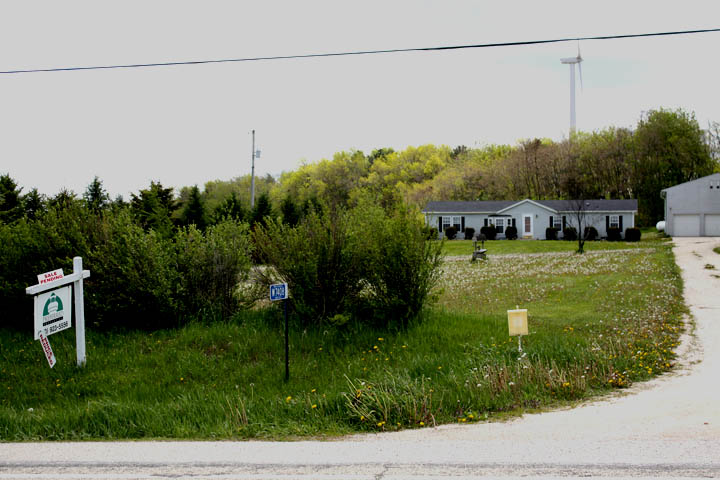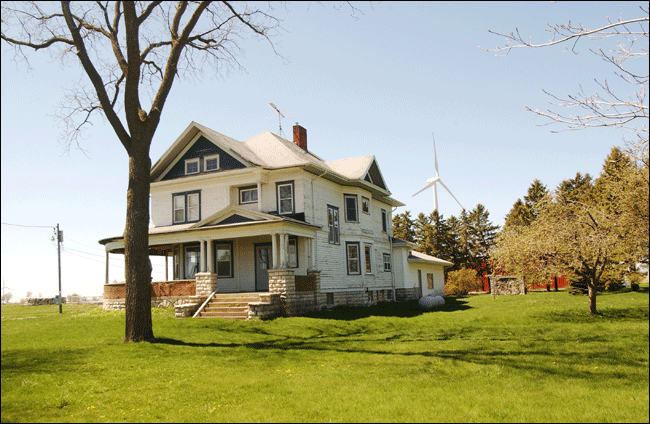Entries in wind farm abandoned home (34)
1/29/11 Like a bad neighbor... Acciona is there and buying your silence by buying your property
NOTE FROM THE BPWI RESEARCH NERD:
Spanish wind giant, Acciona, already has already signed on landowners and holds long term land easements for future wind projects in our state.
TURBINES DECLARED A NASTY NEIGHBOUR AS A SECRET BUYOUT IS REVEALED.
SOURCE: Sunday Herald Sun, www.news.com.au
January 30, 2011
By Peter Rolfe
Victorians who have endured health problems from a nearby wind farm have been gagged from talking in return for the sale of their land.
Spanish multinational energy company Acciona has been quietly buying farms adjacent to its site at Waubra, near Ballarat, as an increasing number of residents in the tight-knit community complain of the ill-effects of living near turbines.
Since the wind farm started operating in July 2009, about 11 houses in the area have been vacated by people complaining of noise problems.
Acciona has bought at least another seven houses, the purchase of two of which appear to have been prompted by the new State Government’s threat to shut down the farm unless noise and permit conditions were met.
Locals in the tiny town of 700, 35km northwest of Ballarat, say the sales took place on the proviso landowners would not talk about the price of the purchase or negative health effects they blame on the wind farm.
Residents who refuse to move have accused the company of trying to buy their way out of trouble.
Noel Deans moved from Waubra to Ballarat 18 months ago because he could no longer stand headaches, tinnitus and poor health he believes are caused by high-frequency vibrations from turbines.
“The word is they’re buying everyone out and buying some of the other properties nearby just to hush them up,” he said.
“They know that we can’t fight them. We can’t win.
“They make you suffer so that you just want to get out of there. They know that it gets to you emotionally and physically.”
Mr Deans refuses to sell his property because he does not want future generations to suffer like his family. He only returns to the farm when he has to — about once a fortnight — and says every time he does he gets head pain within five minutes that takes up to 10 days to go away.
Doctors’ certificates seen by the Sunday Herald Sun back his claims.
“Once (the vibrations) get inside the house it bounces off the walls and makes you feel sick,” Mr Dean said. “If you’re exposed to it outside it goes into your inner ear and affects your balance. It’s put tinnitus in my ears which stops me sleeping.”
He has met the company to discuss his concerns, but said they would only take statements, not answer his questions.
“I said ‘I don’t want you to buy me out. I want you to fix the problem’,” he said. “It’s hell on Earth living out there. That’s what it is.
“And there’s nothing we can do about it. It’s a bloody terrible thing.
“It’s knocked us around. We’re in limbo. We’ve lost two years of our life and we don’t know where it will end. I’ve put nearly 40 years into that place. It’s prime property that I was going to pass down to my son. What am I going to do? I can’t work there without being ill.”
Former National Trust chairman Randall Bell, now president of Victorian Landscape Guardians, said wind farm companies had a reputation for pulling out their chequebooks to make a problem go away.
“What they do is make people sign gag agreements which dictate that they can’t speak about the sales or their health,” he said.
“It’s a way of shutting people up.”
Acciona generation director Brett Wickham said there was no proof wind farms affected people’s health, and the plant, which employed about 70 people, was generally well accepted.
He said the most recent two houses bought by Acciona were purchased in September and October last year, when noise levels detected on the property were in breach of the company’s planning permit.
And he said confidentiality contracts used by the company were “standard practice for the industry”.
“Most of the landowners have actually sought confidentiality agreements as well,” he said.
“They are what they are.”
But Karl Stepnell, who moved his wife and three children out of Waubra after sleepless nights, heart palpitations, ear pressure and nausea that began when the turbines started turning, disagreed.
“They have bought a lot more houses than seven. There are empty houses all over the place,” he said.
“We’re all for green energy, but there have to be more conditions on what the wind companies can do.”
Planning Minister Matthew Guy, who has the power to shut down the wind farm if it does not comply with its permit, said the Government was watching closely to ensure that wind farm operators played by the rules.
“If they are not complying with their planning permit, I would close it down,” he said.
“Just as someone who doesn’t comply with a building permit or doesn’t pay a parking fine would be in trouble, so will they.”
A Senate inquiry into the possible adverse impacts of wind farms will be held later this year.
OUR 'What the--?' WIND VIDEO OF THE DAY:
BE ADVISED: Contents include man singing in French to pictures of wind turbines.
1/28/11 UPDATED: Life in a Wisconsin wind project: who is listening to the residents? AND Update on Big Wind lawsuit in Ontario AND Wind project resident suffers heart-attack during presentation about turbine noise violations AND Stray Voltage and Wind Turbines
THE NOISE MOVED IN NEXT TO THE HOMEOWNERS
SOURCE Journal Sentinel, www.jsonline.com
January 27, 2011
By Patrick McIlheran
In Thursday’s Journal Sentinel, I talk with the neighbors of some wind projects. Frankly, I think wind turbines are pretty atop the ridge south of Fond du Lac, but I don’t live near them. Gerry Meyer does, and he recounts just how loud they are — like a jet plane flying over, or like boots in the clothes dryer.
That’s why, he tells me, he thinks the 1,800-foot line specified in Gov. Scott Walker’s bill on wind turbine siting makes sense. It isn’t a setback — rather, the bill simply requires that anyone putting a wind turbine closer than 1,800 feet to a property line get the permission of the owner on the other side.
Wind advocates say that will kill wind power in Wisconsin. It’s “highly unlikely,” said Clean Wisconsin’s Keith Reopelle, that developers would want to negotiate with neighbors, much less pay them compensation, the likely means by which such permission would be gained.
Besides, said Reopelle, it’s not as if wind turbines are the only noisy thing out there. He mentioned how he used to live along the edge of Interstate 90 south of Madison.
“We’ve never talked about monetary compensation for people who live near highways,” he said.
True enough, but there’s a critical difference: I-90 was a freeway long before Reopelle ever moved next to it. By comparison, rural southern Fond du Lac County was field and wood until about two years ago. Characteristic noises would include the footfalls of deer. “I have not seen a deer here since construction began,” said Meyer, and the owls and hawks that used to frequent his woodlot are gone, too. While someone choosing to live near a freeway is moving next to the noise nowadays (since we’re not building new freeways), in the case of wind farms, the noise is moving in.
FAIR AND OPEN PROCESS? MORE LIKE OUTNUMBERED AND IGNORED SAY TURBINES' NEIGHBORS
SOURCE: Journal Sentinel, www.jsonline.com
January 27, 2011 By Patrick McIlheran
If you look at my column in Thursday’s Journal Sentinel about wind turbines, you’ll notice one of the people I talked to is Larry Wunsch, who lives 1,100 feet from a turbine near Brownsville.
Wunsch was on the panel that the Public Service Commission assembled to advise it on wind turbine siting rules. The PSC was told by the Doyle administration to trump town and county rules on how far turbines should be from houses, and it picked a number, 1,250 feet, that wind advocates say is plenty far enough.
In fact, say advocates, the number is a compromise — tougher than they wanted but less than what wind farm critics sought. “A fair decision arrived at,” said Denise Bode, head of the American Wind Energy Association. The number was arrived at via an open process involving all kinds of stakeholders, she said.
It’s true that wind turbine critics wanted a farther setback — one figure that gets thrown around is a 2-kilometer setback, or more than 6,000 feet. But that the PSC’s figure is less than critics wanted and more than developers did proves nothing about the process that produced the PSC’s rule.
Was, in fact, the process fair? Not really, says Wunsch. For one thing, the PSC’s panel was heavy with advocates of wind, he notes. By law, it had to include two wind-farm developers, two utility representatives (utilities favor easier wind-farm siting), one university expert, one township official, one county official, two real estate reps (who generally want tighter limits), two wind-farm neighbors, and two members of the general public. In this case, one of the members of the public was a former Doyle functionary; the other was Jennifer Heinzen, who happened to be an offical with RENEW Wisconsin, a pro-wind group. It mean RENEW had two people on the council.
“A member of the public should be Joe down at the bait shop,” said Wunsch, and while you might think so, state law made no such specification.
As for whether the council did much listening, again, Wunsch contends it didn’t. He contends he tried playing recordings he made outside his home of turbine sounds — along with sound-meter readings of between 50 and 60 decibels — and was turned down. He says he later suggested just playing an hour of turbine noise he recorded in his backyard during the proceedings as a show of what neighbors endure. “I was told by chair that I could not do that. Any experiment I tried to bring to them they weren’t interested.”
Obviously, a majority of the council disagreed with Wunsch, but that doesn’t lessen the fact that, however lawful and public the process, the neighbors of wind farms felt they weren’t consulted so much as outnumbered and trumped.
Click on the video above to hear what wind turbines sound like. Video recorded by Gerry Meyer who lives in the Invenergy Forward Energy Wind Project. Video camera microphones aren't sensitive enough to fully record wind turbine noise. Even so, the distinct quality of wind turbine noise is very clear here.
CLICK HERE to read Meyer's daily account of life with wind turbines in The Brownsville Diary,
CONCERNS ARE ADRIFT IN THE WIND
SOURCE: Journal Sentinel, www.jsonline.com
January 26, 2011
Patrick McIlheran
If anyone had to ask Gerry Meyer for permission to install a wind turbine 1,560 feet from his house, it isn’t clear he’d have said no.
“At one time, I supported this, because I didn’t know any better,” said Meyer, who lives amid the 86-turbine wind farm south of Fond du Lac, near Brownsville. “I was naive.”
But no one had to ask Meyer anything. As turbines and their neighbors are back in the news, with wind proponents saying Gov. Scott Walker’s proposed change to siting rules will kill wind power in Wisconsin, one thing is becoming clear: Wind backers aren’t doing enough asking or listening to neighbors.
Neighbors are listening, whether they want to or not, to the turbines. Builders say they’re quiet, and Meyer said he believed that – until he stepped outside and looked up for the jet flying over. It was the new turbine nearby. Depending on wind and humidity, any of the five turbines within a mile of his house obtrude on the quiet, whining or thumping “like boots in the dryer.”
Within weeks, his wife and son started having chronic headaches. His wife now suffers constant ringing in her ears. It vanished on vacation. Meyer no longer sleeps much – “The only time I dream is when we go to our cabin,” he said – and he says his blood chemistry’s now a mess. His cortisol returned to normal, and he lost 21 excess pounds when the turbines were off for three weeks. “That should raise a red flag,” he said.
A mail carrier, Meyer talks of dogs grown surly and neighbors who have abandoned farms. One neighbor, Larry Wunsch, 1,100 feet from a turbine, cites “shadow flicker,” when sunlight shines through the blades. “It looks like someone is turning the lights on and off,” he said. The state “says you should be able to put up with that for 40 hours a year.” He can’t. He’s been trying to sell for more than a year.
Elsewhere near Fond du Lac, turbines’ neighbors mention the jet-like noise. “Sometimes it sounds like a racetrack or a plane landing,” Elizabeth Ebertz, 67, of St. Cloud, told the Wisconsin State Journal in August. “They’re just too close to people.” Allen Hass, 56, a Malone farmer, told the paper the rent he got for hosting a turbine couldn’t make up for headaches. “I wish I never made that deal,” he said.
Distance is at issue now that Walker proposes changing the uniform setback the state adopted last year. The Public Service Commission overrode stricter local rules, saying turbines had to be at least 1,250 feet from homes. Walker proposes 1,800 feet from property lines, a distance backers say will kill the wind industry. The existing standard is strict enough, says Denise Bode, head of the American Wind Energy Association, and changing it leaves little room for turbines.
Except Walker’s bill doesn’t say turbines must be 1,800 feet from anything – only that if they’re closer, the neighboring owner must grant permission.
Wind backers feel that’s not workable, says Keith Reopelle of Clean Wisconsin, a group favoring turbines. Neighbors would demand payment, “raising the price of wind power and making wind power less competitive,” he said.
Well, yes, neighbors do complicate things. So do lawsuits, like the one Clean Wisconsin joined to try stopping We Energies’ new low-pollution Oak Creek power plant; the settlement will raise your power bills by $100 million. There are lots of trade-offs in generating electricity, and wind is no exception.
The difference is that with wind, the burden falls heavily on people right next door. It lowers theirproperty value, it affects their health in ways not yet understood and it can be alleviated by paying neighbors for their trouble, a deal that Walker’s bill encourages.
But wind backers aren’t inclined to bargain or even acknowledge a problem. “We live with lots of noises,” such as from roads, said Reopelle. Bode, asked about complaints, replied, “There are always going to be some folks who don’t want development.”
Nothing wrong with development, said Meyer, “but what about our health?” The wind farm, he said, “has completely taken away our quality of life.” Of such complaints, wind’s proponents hear nothing.
SUPPORT SENATE BILL 9: WALKER'S WIND SITING REFORM
Better Plan encourages you to take a moment right now to contact Governor Walker's office to thank him for the provisions in Senate Bill 9, (CLICK HERE TO DOWNLOAD THE BILL) which provides for a setback of 1800 feet between wind turbines and property lines. Let him know you support this bill.
CONTACT
Governor Scott Walker
govgeneral@wisconsin.gov
115 East Capitol
Madison WI 53702
(608) 266-1212
RED ALERT!
It's very important that you contact these key legislative committee members and urge them to support this bill and vote to move it forward. Every phone call and email to these committee members matters.
Members of the Senate Committee on Judiciary, Utilities, Commerce, and Government Operations.
-Chairman Senator Rich Zipperer (R) Sen.Zipperer@legis.wisconsin.gov
(608) 266-9174 Capitol 323 South-Vice Chair Senator Neal Kedzie (R) Sen.kedzie@legis.wisconsin.gov
(608) 266-2635 Capitol 313 South-Senator Pam Galloway(R)
Sen.Galloway@legis.wisconsin.gov
(608) 266-2502 Capitol 409 SouthSenator Fred Risser (D) Sen.risser@legis.wisconsin.gov
(608) 266-1627 Capitol 130 SouthSenator Jon Erpenbach (D) Sen.erpenbach@legis.wisconsin.gov
(608) 266-6670 Capitol 106 SouthAssembly Committee on Energy and Utilities
Representative Mark Honadel (Chair)(888) 534-0021 (414) 764-9921 (South Milwaukee)
Rep.honadel@legis.wisconsin.gov
Representative John Klenke (Vice-Chair)(888) 534-0088 (Green Bay) new
Rep.Klenke@legis.wi.gov
Representative Kevin Petersen(888) 947-0040 (Waupaca)
Rep.Petersen@legis.wisconsin.gov
Representative Gary Tauchen(608) 266-3097 (Bonduel)
Rep.Tauchen@legis.wisconsin.gov
Representative Thomas Larson(888) 534-0067 (Colfax) new
Rep.Larson@legis.wi.gov
Representative Erik Severson(888) 529-0028 (Star Prairie) new
Rep.Severson@legis.wi.gov
Representative Chad Weininger(888) 534-0004 (Green Bay) new
Rep.Weininger@legis.wi.gov
Representative Josh Zepnick(608) 266-1707 (414) 727-0841 (Milwaukee)
Rep.Zepnick@legis.wisconsin.gov
Representative John Steinbrink(608) 266-0455 (262) 694-5863 (Pleasant Prairie)
Rep.Steinbrink@legis.wisconsin.gov
Representative Anthony Staskunas(888) 534-0015 (414) 541-9440 (West Allis)
Rep.Staskunas@legis.wisconsin.gov
Representative Brett Hulsey(608) 266-7521 (Madison)
Rep.Hulsey@legis.wi.gov
And be sure to contact your own legislators and encourage them to support the bill.
SECOND FEATURE
TURBINES, GREEN ENERGY ACT, FACE COURT CHALLENGE
SOURCE: Orangeville Citizen, www.citizen.on.ca
January 27, 2011
By WES KELLER Freelance Reporter,
The fate of Ontario’s Green Energy Act (GEA), as it relates to wind turbines, might hinge on whether a Divisional Court panel of three Superior Court judges rules that the government should have sought proof that there are no harmful health effects from turbines or rules that the government considered adequately whether a standard setback of 550 metres is safe.
An application for a judicial review, brought by lawyer Eric Gillespie representing Prince Edward County resident Ian Hannah, was heard Monday in Toronto over objections from government lawyer Sara Blake, who argued that the court had no jurisdiction as it involves a wind farm proposal that should be subject to the Renewable Energy Approval (REA) process.
The Canadian Wind Energy Association (CanWEA) is a party to the hearing but only as “a friend of the court” and so far only apparently to the extent of submitting information. But its position reflects that of the government.
“In our view this application has no merit and should not be before the court. The proper forum for issues related to setbacks for wind turbine projects is through the Renewable Energy Approval (REA) process. The REA is designed to ensure that renewable energy projects are developed in a way that is protective of human health, the environment, and Ontario’s cultural and natural heritage,” said CanWEA’s media relations officer, Ulrike Kucera in an email response.
The judges have reserved their decision to allow time to review the complex submissions from both sides, but Wind Concerns Ontario is considering that a victory. It says essentially that to have had the case heard at all was a win, and cites three hurdles that it consider it has overcome.
First hurdle: having the case heard;
Second hurdle: the court heard evidence from experts whom the government side said were unqualified;
Third hurdle: the fact of the reserved judgment, as an indication that the panel is reviewing all submissions – including those of the turbine opponent.
Mr. Gillespie’s submissions generally were that the provincial ministry did not consult doctors and did not follow what is known as “the precautionary principle” by which a proposal should be rejected if there is uncertainty about its effects.
Ms. Blake defended the process of the GEA drafting as, she said, the minister reviewed scientific studies. She said the doctors cited by Mr. Gillespie lacked the (expert) qualifications required, and described one of them as “an advocate against wind farms” because an area near his home is being considered for a possible wind farm.
On Tuesday, Mono council unanimously passed a motion by Councillor Fred Nix, asking the provincial government undertake independent third-party clinical research on the health effects of low-frequency noise from wind turbines on nearby residents.
In an interview, Mr. Nix said the motion was largely symbolic, since municipalities have limited authority under the Ontario Green Energy Act.
“This says to the government what a rural municipality thinks,” said Mr. Nix. “They say a safe setback for turbines is 550 metres.
“Do we have a research that says this is safe? I say we don’t.”
While he admitted a motion passed by a single, relatively small municipality bears practically no weight, Mr. Nix was hopeful the message would bring other towns and cities on side and they could make their collective case through the Association of Municipalities of Ontario (AMO) or the Rural Ontario Municipal Association (ROMA).
“There is strength in numbers, he said,” he said. “We will have a lot more powers if we can get more municipalities on our side.”
The outcome of the court hearing is of vital interest to the Whittington Coalition for Our Right to a Healthy Living Environment, the group opposing a 6.9 megawatt wind turbine installation at Mono- Amaranth Townline and 15 Sideroad, in large part because they believe the 550-metre setbacks are inadequate.
But it is of critical interest to the Ontario government itself as it has been relying on a deal with Samsung and a South Korean turbine service proponent to create thousands of industrial jobs while bolstering Ontario’s production of green wind energy.
THIRD FEATURE
SOURCE: Wind Turbine Syndrome News
Art Lindgren, a leader of the effort opposing excessive noise from Vinalhaven wind turbines, suffered a heart attack last night at a board meeting of the Fox Island Electric Cooperative.
Lindgren had been in the midst of an evening presentation about the reporting by Fox Island Electric to ratepayers and ongoing complaints about violations of state noise standards. The informal entity Mr. Lindgren leads—Fox Islands Wind Neighbors—has urged the State of Maine to enforce the law against Fox Islands Wind, the turbine operator.
At considerable effort, cost, and often under severe weather conditions, Mr. Lindgren mastered complex acoustic measurements, providing data from wind turbines from this rural, quiet area in Maine.
Lindgren was airlifted from Vinalhaven, ten miles from the Maine coast, by LifeFlight helicopter last night after being resuscitated by observers.
He is under treatment at Eastern Maine Medical Center in Bangor, ME.

Art Lindgren, Vinalhaven, ME
Below, a view of a wind turbine from the Lindgren home
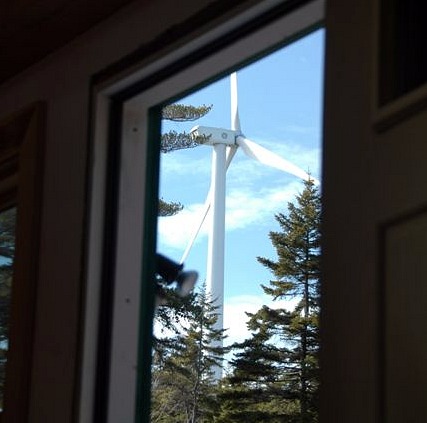
Stray voltage an ongoing issue in wind farm areas
By TROY PATTERSON , KINCARDINE NEWS STAFF
Municipality of Kincardine had an education on the effects of stray voltage and electrical pollution caused by area wind power projects last week.
Ripley's David Colling, an expert and electrical pollution tester, has tested over 300 homes and farms within four Ontario wind projects over the last five years.
After working with stray voltage issues on dairy farms, the added issue of wind turbines was a surprise to him when he discovered electrical pollution in nearby homes.
"I never would have believed this would have happened," said Colling regarding the "wind victims" he has come to know.
Working with other experts in Canada and the United States, Colling is convinced many of the issues surrounding wind power health issues stem from either electrical pollution caused by turbines through their distribution system, or the low frequency noise that comes off the blades. He said people from Ripley, Bruce Township and Shelburne have fallen ill to what he called 'Wind Turbine Syndrome' and 'Electrohypersensitivity' caused inaudible noise and "dirty electricity" polluting the electrical systems of homes within range of wind turbines.
He said people have had to shut their power off, or in worst cases move from their homes. In many of these cases those people have been unable to sell their homes.
"We have four empty homes in Ripley due to this," he said, adding the wind company has attempted to resolve the issue by burying power lines but with limited effects.
Colling gave a detailed presentation with photos and figures to back up his claims, along with examples of his electrical tests in the area. He said "Harmonic Distortion' is something that has been acknowledged by wind companies, although they dismiss the other impacts, he said.
"And I know more people out there who are sick," he said. "I didn't ask for this. I just happened to be dropped into an area where it's happening."
Counc. Ron Coristine said he found the presentation "deeply troubling" and said the data should be used to continue the wind power debate in the area.
"As long as there is a debate, it's our responsibility to engage in it," said Coristine. "It's not good enough for us to ignore this. We shouldn't have to be an electrical engineer to protect ourselves from electricity."
Colling said the issues will continue and for council to be mindful, as the area is on an "outdated, overloaded (electrical) system," where this is bound to continue, he said.
1/17/11 How's that industrial wind turbine thing working out? Like a bad neighbor, Acciona is there. AND Perception VS. Reality: Putting the Green Spin on Wind Energy AND Wind Lobbyist's tantrum about Walkers proposed setbacks AND Extra Credit Reading List
WAUBRA RESIDENT TELLS COURT OF WIND FARM "HELL"
SOURCE The Courier, www.thecourier.com.au
January 18 2011
Former Waubra resident Trish Godfrey yesterday told an Adelaide court how her dream home became “hell on earth” after wind farm turbines were turned on.
Ms Godfrey said she suffered sleep deprivation, headaches and nausea before moving out in April 2010 when Acciona purchased her property.
“It was like you had a hat on that’s too tight and you have a pain that just gets worse and worse, and you can’t take it off,” Ms Godfrey said. “There was pain most of the time.”
Ms Godfrey broke down in tears as she gave evidence at the Environment Resources and Development Court.
Dairy farmer Richard Paltridge is appealing a decision to grant Acciona approval to build a 46-turbine wind farm near his property, south of Mt Gambier.
Ms Godfrey said her symptoms began about a month after turbines were turned on, then got progressively worse.
“I said to my husband I’m not sick but I don’t feel well,” she said.
“It felt like I had a cold coming on all the time.
“My sleep patterns were changing. I was waking up two, three, four times a night. I couldn’t explain it. I couldn’t get my head around what was going on.
“You put it down to everything but what it is.”
Ms Godfrey said she and her husband Victor, a dental surgeon, went on holiday to Darwin and the symptoms stopped, then resumed when she returned home.
“You get back and it starts all over again,” she said. “It all came back with gusto.”
Under questioning by George Manos for Mr Paltridge, Ms Godfrey said the 10-acre property was her “dream” home, where she and her husband intended to retire.
She said she planted 750 to 1000 boundary trees, about 30 fruit trees and 17 vegetable beds in the 10 years they lived there.
Ms Godfrey said she had been led into a false sense of security in a meeting with David Shapiro of Wind Power, the company that set up the Waubra project and sold it to Acciona.
“He told us there would be a couple of turbines on Quoin Hill, a couple on Big Hill and a few behind us,” Ms Godfrey said.
“He said there would be no lights, no wires and no noise.”
Ms Godfrey said 63 turbines could be seen from her property and it became “hell” to live there.
She said the noise “pressed in” on their home. “It was anywhere from a low whooshing sound, a sweeping swoosh some days, and when the wind was coming from the north it was like a jumbo jet in the back paddock,” she said.
Former Waubra resident Carl Stepnell told the court yesterday he and his wife’s symptoms of chest pains, heart palpitations and sleep deprivation ceased after the couple moved away from the family farm to Ballarat in November.
“We feel as though we’ve got our health back,” Mr Stepnell said.
Mt Stepnell said his wife also suffered depression while living close to the turbines.
“Her whole appearance … it was scary to see how bad she was,” he said. “She was really down, depressed … shocking.”
Mr Stepnell said his five-year-old son attended Waubra Primary School until the family moved.
“I see a big difference in his behaviour,” he said.
“He is nowhere near as emotional … he was pale. (Now) he’s like a normal five-year-old.”
SECOND FEATURE
PERCEPTION VS REALITY
SOURCE: he Republican-American, www.rep-am.com
January 16, 2011
By Bill Gregware,
Wise people (and politicians) often say perception is more important than reality. Take the case of wind energy in Connecticut. What are the perceptions and what are the realities? With the proposed wind projects in Colebrook and Prospect currently being so hotly debated, perhaps it’s timely to consider a few points.
Wind power will lower the cost of electricity. The promoters of wind power frequently start their pitch by saying Connecticut has the highest rates for electricity within the continental United States. That is true, and the target audience often comes away with the impression more wind power will mean a decrease in electricity costs.
The reality is electricity generated from wind is much more expensive than that produced from traditional sources. It’s often stated wind-generated electricity costs 15 percent to 20 percent more than does that generated by coal, but the actual cost may be even more. It is difficult to calculate because of the variables involved. Only in rare cases is it lower than 15 percent more than coal-generated electricity. And with wind power, consumers not only pay higher prices for electricity, they are, as taxpayers, also paying for the generous subsidies this industry is receiving. Without subsidies there is simply no way wind power can compete economically.
Oil imports will be reduced. A misleading perception is that more wind turbines will reduce our dependence on foreign oil imports. The American Wind Energy Association (AWEA) says, “Unlike the dirty energy from fossil fuels, wind energy does not cause … dependence on unfriendly foreign regimes.”
In reality, wind energy may not cause the dependence but does nothing to reduce it. The majority of the electricity produced in the United States is derived from domestic sources: coal, about 45 percent; natural gas, 25 percent; nuclear, 20 percent; and hydroelectric, 6 percent, not from burning fossil fuels imported from other nations.
The danger in promoting such claims is that it leads the public into thinking something positive is being done to curb oil imports and this very serious problem is being solved. People are then less apt to support the implementation of projects that could improve the environment and reduce imports of oil, such as increasing emphasis on efficiency and conservation.
Environmentalists support wind power. The promoters of wind power make every attempt to show “true environmentalists” support wind power while opponents are anti-green. The truth is growing numbers of hard-core environmentalists are becoming disillusioned with wind power.
In his book “The Wind Farm Scam,” Dr. John Etherington, a highly esteemed UK ecologist and beyond doubt an avid environmentalist, wrote: “The specter of climate change is being used as a scare tactic to get people to buy wind power. This is the old quack-doctor trick — scare them to death and they’ll buy anything. It (wind power) will certainly be seen by history as a swindle supported by untruths and half truths.”
Property values are unaffected by wind turbines. The wind industry has taken a hard-line approach to the property-value question. It often presents detailed reports by “experts” that indicate property values do not decrease in the vicinity of wind turbines. Most of these reports are written by wind advocates using flawed data and reaching invalid conclusions.
The answer to the property-value question is found in common-sense reasoning. Who, given a choice, would want to live near these devices? How many potential buyers would seek homes in the vicinity of a wind turbine? For that matter, how many executives of the wind industry live near turbines?
Numerous anecdotal stories tell of folks being unable to sell their homes and abandoning them because they could no longer tolerate the noise or other characteristics of turbines.
Wind power will replace dirty power plants. “U.S. winds contain enough energy to provide over 10 times our total electricity, and to fuel a large portion of our auto fleet with electricity as well,” says the AWEA, giving the perception we can eliminate existing conventionally powered plants.
Think of that! All we have to do is to cover our countrysides with wind turbines and the dirty old coal plants can be shut down, with enough electricity will be left over to fuel electric cars. The problem is the intermittent nature of wind means it must have backup. Wind turbines have never replaced a traditional power plant.
Wind power means jobs. Jobs are created by the wind industry, but that can be said of any industry. The perception the promoters try to depict is that wind power means a great many new jobs for local workers. However, most of the work is in the manufacture of the turbines, which is done far away from the site, perhaps even in a foreign land. And once they are in place, turbines require little manpower except for once a year or so routine maintenance.
Why does the wind industry work so hard hawking half truths and hyperbole to create false perceptions that wind power is so wonderful, even in relatively low-wind areas like Connecticut?
It’s because a bad idea is difficult to sell. The reality is that wind power is not about “going green.” It’s all about money.
Bill Gregware (gregwarebill@hotmail.com) of Goshen is a retired oil company geologist/exploration manager. He is also an avid environmentalist and freelance writer who specializes in writing about nature and energy. Further, he is a party to those fighting the proposal by Optiwind to build a turbine in Goshen.
THIRD FEATURE
SOURCE: WindAction Editorial
 Denise Bode, Head of AWEAAWEA has a tantrum -- again
Denise Bode, Head of AWEAAWEA has a tantrum -- again
(Posted January 16, 2011)
Wind energy is unreliable.
But there's one thing we can always count on -- AWEA tantrums, which are getting to be regular occurrences.
Last month we were treated to a week of whining by the American Wind Energy Association after the Obama Administration and GOP leaders released the terms for extending the Bush-era tax cuts. The outburst was triggered after learning the tax agreement negotiated with the White House omitted any reference to extending the Section 1603 tax grant program (ITC), a program introduced in 2009 under ARRA (American Recovery and Reinvestment Act of 2009) and due to sunset end of 2010. The costly stimulus program provides direct cash grants to wind developers in lieu of the production tax credit for up to 30% of their capital costs, no questions asked. Like a recording stuck on replay, AWEA's Denise Bode's shrill warnings about job loss and immediate harm to the industry repeated non-stop until lawmakers relented and sanctioned a 1-year extension.
Last week, AWEA was in a huff again. This time the target was the new governor of Wisconsin, Scott Walker.
For more than five years, communities throughout Wisconsin worked within State law to establish local regulations that would protect homeowners and families from improperly sited wind energy projects. Projects under 100 megawatts were subject to these local standards which stood as models for other communities worldwide[1].
The wind industry complained bitterly to then governor Jim Doyle and the State legislature about the new local regulations. With setbacks ranging from 1800 feet to 1 mile, the industry insisted the laws were nothing more than "de facto moratoria" and should be overturned.
In September 2009 the State complied. Senate Bill 185 was signed into law placing all wind energy oversight in the hands of the Wisconsin Public Service Commission ("PSC"). Last year, the Commission voted on siting rules recommended by the advisory Wind Siting Council. The PSC's new siting standards became law on January 1.
Thousands of man-hours invested by communities in research, public hearings, and expert testimony were erased and replaced with some of the weakest standards Windaction.org has reviewed, especially for a State with a long history of turbine complaints filed by its residents. The most egregious of the rules involved setback distances (1250 feet as measured from to the outside wall of a residence or community building), noise limits (50 dBA during daytime hours and 45 dBA during nighttime hours) and shadow flicker (30 hours per year).
Last week, Wisconsin's new governor, Scott Walker entered the debate and like clockwork, AWEA had a fit.
In his proposed regulatory bill, Walker included a provision that increased turbine setbacks to 1800 feet from the property line.
Within a day of his bill going public AWEA's temper tantrum was in full swing.
"Job killer!"
"New regulation effectively bans wind energy projects in Wisconsin."
"One of the most onerous regulations we have seen."
"A shock to those of us in the wind industry."
"Wisconsin does not want our business."
You get the picture.
And there's no question the pitch will rise and the rhetoric will become even more extreme in the days ahead. We've seen it before from AWEA -- wild and unsubstantiated claims played over and over until the government blinks. And since the group has had some success with tantrums it's no surprise it doesn't bother to change tactics.
But Ms. Bode may want to check her facts on wind regulations. Setbacks of 1,800 feet are hardly the largest in the United States or worldwide. If projects in Wisconsin are unable to meet this limited standard then it could be the population density in the State is too high for safe wind development. But expecting AWEA to respond in a realistic and professional manner is probably asking too much.
Governor Walker has taken an important first step towards recognizing that the residents of Wisconsin deserve consideration. In an e-mail statement to media outlets in Wisconsin, Walker's spokesman Cullen Werwie said the proposal is aimed at "addressing concerns on wind energy policy that impact homeowners" and that "the proposed legislation, if enacted, will protect private property owners' rights."
Perhaps AWEA's members should remove their wind hats for a moment and at least try to imagine what it means to live in the shadows of the massive towers they're erecting. They might see that eighteen-hundred feet is still much too close.
[1] Larger projects, those greater than 100 megawatts, fell under the jurisdiction of the State's Public Service Commission.
EXTRA CREDIT: CLICK TO READ....
What's this about 'clean' wind energy's toxic footprint?
Last week it was reported that China - which has a global monopoly on the production of rare-earth metals - is now threatening to cut off vital supplies to the West. A shortage would jeopardise the manufacturing and development of green technologies such as wind turbines and low-energy lightbulbs.Last week it was reported that China - which has a global monopoly on the production of rare-earth metals - is now threatening to cut off vital supplies to the West. A shortage would jeopardise the manufacturing and development of green technologies such as wind turbines and low-energy lightbulbs.
11/20/10 The problem with the noise that's not a problem: Like a bad neighbor, Invenergy is there AND Why would 7 families abandon their homes? AND Big Wind says unless the rules are bent, it's taking its ball and going home AND How now cash cow? Fed $$$ milker dries up for Big Wind
Wind Fight Keeps on in Morrow County
SOURCE: East Oregonian, www.eastoregonian.com
November 19, 2010
Erin Mills
IRRIGON — Both parties involved in the fight over noise from the Willow Creek Energy Center have again appealed a Morrow County Planning Commission ruling to the Morrow County Court.
The planning commission’s Oct. 26 ruling expanded on its earlier decision — also appealed to the county court — that found the wind project in violation of state noise rules and gave it six months to comply.
The company that owns the 48-turbine project, Invenergy, appealed the ruling because “the planning commission’s decision incorrectly construed the applicable noise standard and was not supported by substantial evidence in the record,” according to its appeal application.
The four neighbors who live near the project appealed the ruling because it did not immediately ensure compliance with the noise rule, particularly at night, and didn’t force Invenergy to pay for the neighbors’ noise study.
The Morrow County Court is scheduled to review the issue Dec. 8 at 10 a.m. at the Riverfront Center at the Port of Morrow.
SECOND FEATURE
BRUCE COUNTY COUNCIL BACKS CALL FOR TURBINE STUDY
SOURCE: The Sun Times, www.owensoundsuntimes.com
November 18, 2010
By Don Crosby,
Bruce County council is throwing its support behind a request from Huron-Kinloss that the Grey Bruce Health Unit study the health effects of wind turbines close to homes.
"I have a lot of people in my community that have been sick since the turbines [have been] up and working. We hope if we pass this resolution around to other municipalities we'll gain some support. Take this to the health board and hopefully Dr. [Hazel] Lynn will see fit to take it to the next level, whether that's a health study or whether it's getting other health units in other counties involved in this process," Huron-Kinloss Mayor Mitch Twolan said after Thursday's meeting of the county's agriculture, tourism and planning committee.
"I think it's very important that no further turbines are erected until some sort of health study is done."
Twolan said he knows of seven families who left their homes since 38 turbines became operational in the Ripley area.
There are proposals for another 50 turbines in Huron-Kinloss and Twolan said he's hearing of other people who say they are affected but haven't said anything.
"There is a silent majority out there that have not come forward to state their concerns because they don't want it to be public. So in the best interest of all our people in all of our municipalities I think this is very important," he said.
Kincardine Mayor Larry Kraemer, who has long been on the health unit's board of directors, said he doesn't believe the medical officer of health can undertake this kind of study herself, but voted to support the Huron-Kinloss resolution.
Lynn earlier this year called on the provincial government to conduct studies to clear up claims of people who say they are suffering from living too close to wind turbines.
Twolan said there is still too little information available to the general public and municipal leaders, who feel left out of the loop yet take the brunt of complaints.
"We're told in the Green Energy Act that everything is in order and in place, yet we have people sick in our community . . . I think it's incumbent on us as leaders at the municipal level to hear their concerns and take it to the next level," he said.
Twolan said energy companies have tried to solve the problems of the seven families who moved.
"In fairness to them they have tried to rectify the situation, but before we move forward in new proposals let's have all of the answers in place and these concerns addressed," he said.
Although Twolan was acclaimed as mayor in the recent election he says concerns about the effects of wind turbines on residents was uppermost in the minds of the electorate.
Residents have given him and his council a second chance, but expect them to do something about these concern, Twolan said.
"As long as you take the message to the next level people will listen. And I genuinely believe in my people. We have issues and we have concerns. The Green Energy Act and these wind turbines are more than just about green energy. There are people out there that are just not happy with this whole process," Twolan said.
Bruce County councillors voted unanimously to support the Huron-Kinloss resolution.
THIRD FEATURE:
IBERDROLA HALTS PLANS FOR WIND INDUSTRY FARM
SOURCE: Putnam County Sentinel, putnamsentinel.com
November 18, 2010
Marlena Ballinger, Managing Editor,
OTTAWA – According to an e-mail sent to the Putnam County Commissioners last week by CIC director Martin Kuhlman, the Wind Energy Project in Putnam County has come to a standstill.
Kuhlman stated in the email that Iberdrola is upset because a Sentinel reporter was present during a phone call between Iberdrola representative, Tim Lang and the Commissioners.
Before last Friday’s commissioner’s meeting, Van Buren Township trustee, Denny Schroeder spoke to commissioners, Travis Jerwers and Vince Schroeder regarding the proposed withdraw of Iberdrola. Commissioner John Love was in Columbus. Denny was basically upset because the commissioners refuse to accept the proposed $4200 per megawatt Iberdrola has agreed to pay.
The project would have generated about 150 megawatts resulting in a $630,000 annual payment from Iberdrola.
According to Senate Bill 232 a company wishing to build a wind energy farm is required to pay in lieu of taxes (PILOT) $6,000 to $8,000 per megawatt to the entities involved but not to exceed $9,000.
The entities involved in this project include Leipsic School district, Van Buren Township and the Putnam County Commissioners.
Over 15 years, the proposed $630,000 per year would be divided out via the school district receiving 72.9 percent, Putnam County receiving 15.3 percent and Van Buren township receiving 11.89 percent.
The commissioners stand alone in the fact they feel Iberdrola should have to abide by Senate Bill 232.
Van Buren township trustees and the school board are willing to go along with the offer presented to them from Iberdrola.
FOURTH FEATURE
WIND ENERGY, SOLAR POWER, FACE CLOUDY FUTURE
SOURCE CNNMoney.com, money.cnn.com
November 18 2010
By Steve Hargreaves, senior writer,
After years of rapid growth and darling status among many in Washington, the future of the American renewable energy industry is uncertain.
That’s because the government cash it has come to rely on may dry up on Dec. 31.
Before the Great Recession, renewable energy developments were helped by a tax credit, worth generally 30% of the cost of the project. When the recession hit, the stimulus package replaced those tax credits with direct cash grants of similar value. Cash is considered more beneficial than credit to the industry.
So far, the government has handed out about $5.4 billion, according to the Energy Department.
Congress could vote to extend the grants, but that’s highly unlikely.
If they’re allowed to expire, incentives for renewable energy will revert to the old tax credits.
“This is not a great place to be in,” said Denise Bode, head of the American Wind Energy Association. “It’s an economic opportunity that will be missed.”
The wind industry is already hurting — even with the cash.
The amount of new electricity wind can generate declined 72% in the third quarter compared to the same time last year, according to the wind association.
The wind industry isn’t the only one saying it will suffer.
Without the cash grant, “we’ll grow at a much smaller rate,” said Edward Fenster, CEO of Sunrun, a San Francisco-based company that installs solar panels on people’s homes.
“They’ve ensured that we’re building something new everyday,” he said
Sunrun has 7,000 customers in seven states. The company installs $1.1 million worth of new systems every day, employing 3,000 contractors.
Fenster said the cash grants let him get cheaper loans than the old tax credits, enabling him to reduce the price of the solar energy he sells by up to 25%. He predicts that price reduction would allow him to double his business next year.
But with “cut spending” the mantra on Capitol Hill, slower growth may be the new reality.
“On a gut level, a lot of the conservatives just don’t like to see the government handing out checks to people,” said Kevin Shaw, an energy lawyer at Mayer Brown. “I just don’t see the grant program being extended.”
But the White House does. The Obama administration has proposed a plan: Pay for it by using money left over from the stimulus package. That’s led some analysts to at least give it a shot at passing.
“You have a road map from the White House,” said Whitney Stanco, an energy analyst at the Washington Research Group. “And previously, Republicans have been amenable to using unspent stimulus funds to pay for other priorities.”
A spokesman for presumed Speaker of the House John Boehner wouldn’t get into details about what the incoming house might fund.
He did say that Republicans support all forms of energy development, including renewables and nuclear power, provided that any money for them comes from expanded domestic oil and gas drilling, a prospect that looks dim.
There’s another piece of legislation that could provide support for the renewable industry besides the cash grant — a mandate that would require utilities to buy a certain percent of their power from renewable energy.
About 30 states already have such a mandate, and the industry has been pushing hard for a federal standard of at least 15%.
But most analysts say that while a broader “clean energy” standard that includes nuclear and natural gas may have a slightly better chance of passing, neither idea will gain traction in the next year.
Even absent the cash grants or the requirement to buy renewable power, some analysts say the sector is not doomed.
Michael Hennessy, a wind analyst at Bloomberg New Energy Finance, is predicting wind turbines will add about 8 gigawatts of power in 2011.
That’s up from 5 or 6 gigawatts projected for hard-hit 2010, but below the record breaking 10 gigawatts in 2009.
The country has about 1,100 gigawatts installed from all sources, with wind accounting for the vast majority of what people consider renewable energy.
“It doesn’t bode horribly in our view,” Hennessy said of the cash grants expiring. It’s just not as good as it could be.
10/14/10 On being a red square in a yellow circle: A wind siting council member weighs in on the real cost of Wisconsin wind farms AND Wind Turbines Too Loud? Sorry Charlie, ain't a lot we can do for you now.
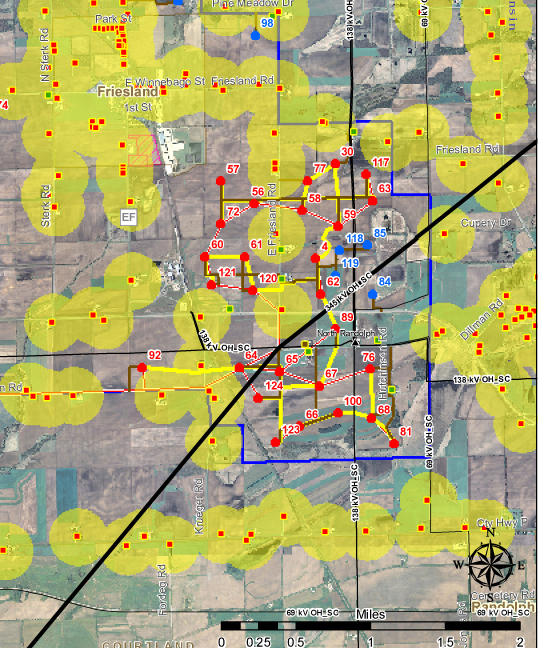
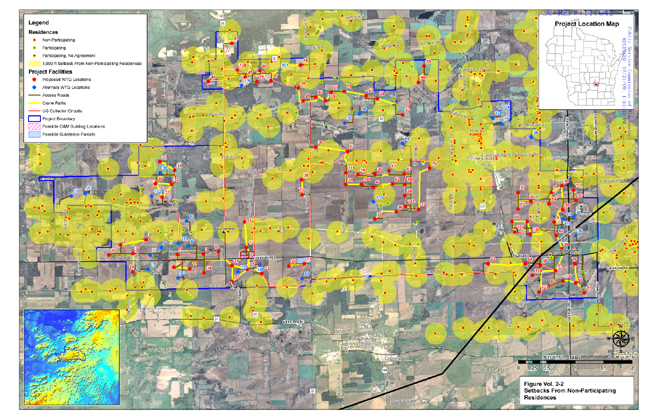
HOW MANY RESIDENTS WILL BE AFFECTED BY THE NEW WIND SITING RULES?
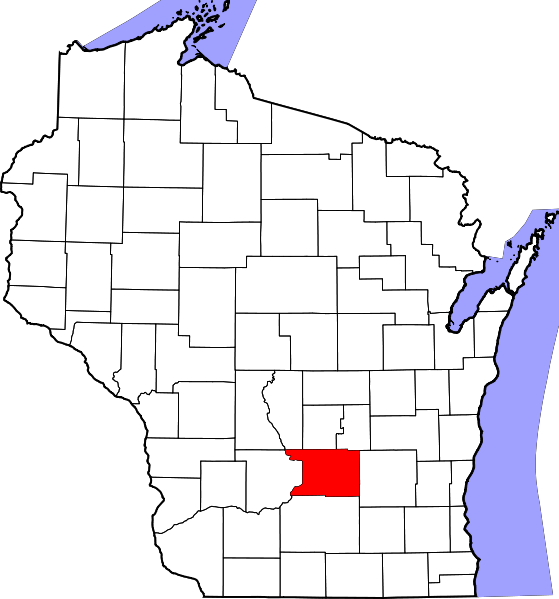
The red squares in the yellow circles on the map above represent non-participating homes in the WeEnergies Glacier Hills wind project currently under construction in Columbia County.
The larger red dots are the turbine locations. [Scroll down to see more detailed maps.]
The new wind rules adopted by the Public Service Commission have the same setbacks from homes as were used for this project.
One difference is the PSC required WeEnergies to offer to buy two homes in the project because seven turbines were to be located within half a mile.
The new rules do not include this sort of protection. Chairman Eric Callisto said by law homeowners have the right to sue the wind developer/owner and he felt that was all the protection they needed.
Although Wisconsin wind farm residents who have been forced to try to sell their homes because of turbine noise and shadow flicker have found no buyers, local wind developers say 400 to 500 foot tall wind turbines located less than 1500 feet a home have no impact on property values.
[CLICK HERE to watch Wisconsin Eye video: During the panel discussion, WPPI vice president Dan Ebert and WeEnergy's head of wind development Andy Hesselbach explain why turbines do not affect property value. ]
Or CLICK HERE to link directly to the Wisconsin Eye 'Newsmakers' feature "Future of Wind Energy"
Developers also say Wind energy is the cheapest way to get renewable energy and cite surveys which indicate stong public support for wind power.
Wind siting council member and Wisconsin realtor Tom Meyer weighs in on the matter.
This is not a question of whether or not people like, or favor "wind" as the lobbyists try to argue. Everyone likes wind, sun, water, earth.
The issue is this: The total cost of generating energy by the use of 400 and 500 foot tall turbines in Wisconsin’s rural communities.
Developers admit that they cannot get investors, who are primarily foreign investors, to put their money up unless the costs of access to the land are depressed.
To get the biggest area to install the highest number of 400 to 500 foot tall turbines, the developer needs to have the greatest access to the most land and compensate the fewest people with the least dollars.
The developer does not need your land, he needs to get one foot [away] from your land.
Every foot the developer is made to move away from a landowner whom he does not have to compensate, adds cost to the developer and reduces the bottom line to investors.
Every dollar spent to gain access to the right to disturbing the peace of a landowner reduces the bottom line.
For wind turbines to be profitable, the industry could improve the technology or depress the cost of access to the land.
By their actions, they prove they believe depressing land costs is more favorable than investing in improving the technology.
Their answer to improved technology is taller and more intrusive. That's not a real solution.
If the turbine can't produce energy without imposing on neighbors, there is no reason to spoil the earth, and threaten the water, and block the sun, to catch the wind.
-Tom Meyer
Wisconsin Wind Siting Council Member
NOTE: Tom Meyer was one of the authors of the minority report from the wind siting council. The report details why some council members strongly disagree with the recommendations sent forth to the Public Service Commission.
CLICK HERE to download pictures of homes in Wisconsin wind projects.
Below, detail maps of non-participating residences in WeEnergies Glacier Hills Project
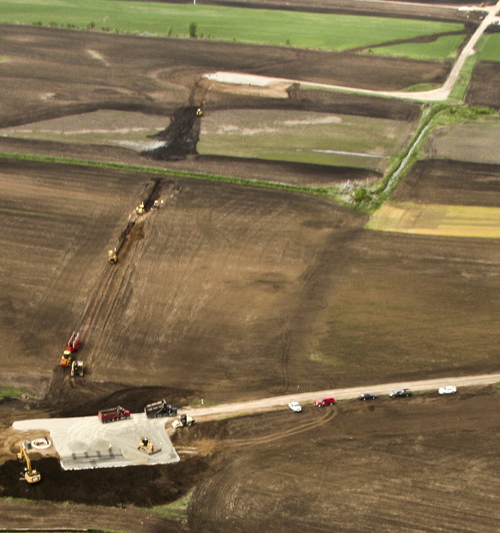

NOTE FROM THE BPWI RESEARCH NERD:
The project mentioned below was sited with the same setbacks and noise limits used to site the We Energies Glacier Hills project. (Detail maps above)
NO EASY SOLUTION TO WIND TURBINE PROBLEM
The Associated Press
VINALHAVEN, Maine (AP) -- The CEO of the electric cooperative that installed wind turbines on Maine's Vinalhaven island says there's disagreement over data suggesting they're too noisy.
Fox Island Wind CEO George Baker says his experts dispute the findings of a Department of Environmental Protection consultant who says the turbines violate nighttime noise limits.
State law sets a 45-decibel limit. Baker says his experts believe it was ambient noise from wind rustling through trees that exceeded 45 decibels, not the turbines themselves.
Baker says it'll be a difficult issue to resolve. He told The Associated Press on Tuesday that slowing the turbine blades to lower the noise level by a couple of decibels may not make appease critics. And lowering it further could hurt the economic viability of the project.


